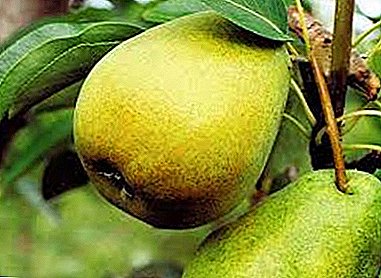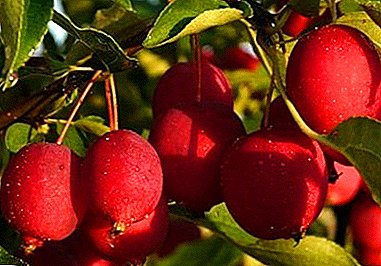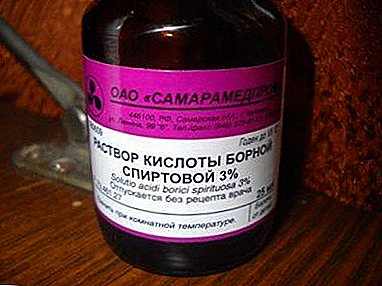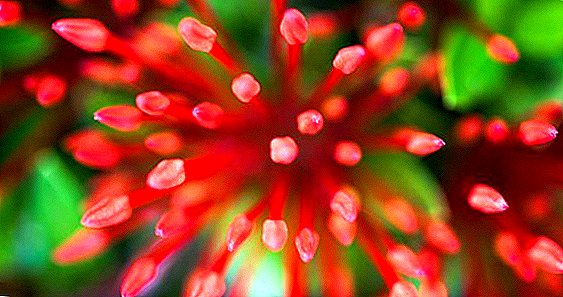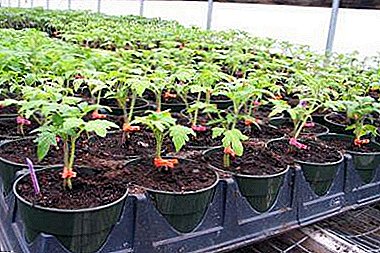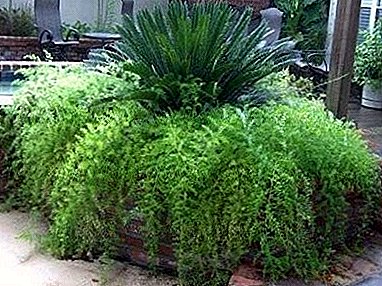
Asparagus pinnate enjoys special attention among flower growers.
This unpretentious, magnificent plant is able to decorate the apartment, to create an atmosphere of comfort.
Fen-shui culture admirers believe that asparagus cleans the energy of the apartment from negative emotions, helps to cope with sadness and depression.
Description and characteristics
 Asparagus Cirrus - a perennial evergreen shrub with curly thin stems.
Asparagus Cirrus - a perennial evergreen shrub with curly thin stems.
The leaves are reduced and are small scales.
The function of photosynthesis will be performed by modified, thin, slightly curved, stems (phylloclades). They are formed in the form of bunches, on each of which up to 12 stems are located. The flowers are small, white.
Fruits - blue-black berries with seeds inside. Threadlike stems give the appearance of the plant a decorative, openwork look.
In habitat, distributed in subtropical, tropical forests of Africa.
Some photos with this plant:


Other common types of Asparagus on our website are: Sprenger, Sickle, Meyer.
Home care
To care for the plant is not difficult. It is enough to follow simple recommendations.
After the purchase
The very first, important stage. Unfortunately, many growers do not pay enough attention to him and may later face a number of problems.
Even if you bought asparagus from the market with your hands or took it from your neighbor, you will have to perform this procedure. The former soil may not be sufficiently nutritious or infected by pests, and therefore will be dangerous to the health of other indoor plants.
During transplantation, be sure to inspect the root system. She must be strong, healthy.
After purchase, accustom the flower to intensive lighting gradually.
Lighting
 The best place for asparagus is window sills facing the west or east side.
The best place for asparagus is window sills facing the west or east side.
The flower likes good lighting, but does not tolerate hitting the direct rays of the sun. If the pot is on the window sills of the south side windows, create ambient lighting.
In warm weather it will be useful to carry the plant to the air, but do not leave it under the sun.
The lack of illumination in winter, asparagus suffers not badly, it rarely needs artificial additional illumination.
TIP: It is recommended to accustom to light in the spring gradually.
Temperature
In the spring and summer, maintain a warm, moderate indoor temperature - no higher than 25 degrees. In winter - about 14-16 degrees.
It is necessary to maintain a cool temperature in winter, otherwise the plant will begin to lose its decorative appearance, the stems will gradually become bare and wither.
Watering
 Asparagus loves moisture, so watering and spraying should be given special attention.
Asparagus loves moisture, so watering and spraying should be given special attention.
In the summer, spring, the earth is moisturized about 3 times a week.
On hot days you can more often.
In winter, there comes a time of rest.
Watering is reduced, but make sure that the soil is not completely dry.
Humidity
In its natural environment, asparagus grows in southern forests with high humidity, so it is recommended to create similar conditions at home.
Spray the plant often with a spray bottle.
In winter, do not place the pot near heating appliances and radiators.
TIP: Purchase a floor-mounted humidifier to keep indoor air dry. You can put a container with water next to the pot, spray air next to the flower.
Pruning
Note! Asparagus does not need pruning. Shoots after it cease to grow. But, the old bare shoots still need to be cut off. This will stimulate the growth of young shoots from the roots.
Transfer
Indoor asparagus is sensitive to transplants, so this should be done only if necessary - after purchase and when the pot becomes small in size. Adult plants are transplanted once every three years, young every year in spring.
Transplant technology is simple:
- Prepare a fresh substrate and a suitable container. Fill the drainage embankment at the bottom of the tank.
- Carefully remove the plant, shake off the roots of the earthy coma, slightly shorten the tips of the roots. Yellowed and naked stems can be removed.
- The flower is placed vertically in the container and the roots are covered with earth, slightly tamping from above.
- It is not necessary to fill the pot to the very edge, since as the roots grow, the soil rises a little upwards.
TIP: Adult plants are recommended to be transplanted in the early spring using the transshipment method.
Soil and fertilizing
 Indoor asparagus is suitable universal, high-quality soil mixture based on humus, sold in a flower shop.
Indoor asparagus is suitable universal, high-quality soil mixture based on humus, sold in a flower shop.
You can cook it yourself from leaf earth, humus and river sand (approximately in equal proportions).
Another option - a mixture of turf and sheet soil, sand and peat.
You can feed up any complex fertilizers, but only during the period of active growth.
In winter and autumn, asparagus does not feed.
Breeding
Indoor asparagus can be propagated by seed, cutting or dividing rhizomes.
Seeds are better to buy in a specialty store. They are sown in a moist substrate consisting of peat and sand from January to March.
Grown in greenhouse conditions, maintaining a temperature of 21-22 degrees. The soil is regularly aired and sprayed. Seeds sprout well. After 3-4 weeks, seedlings appear, after which the plant begins to actively grow and develop. In early June, sprouts can be seated in pots.
- Rhizome division is a simple, common method. Shrubs are divided into two (or more) parts during transplantation and transplanted into different containers. Perform the procedure carefully, be sure to disinfect the instruments used.
- Cutting is also a common, simple way to divide. In early spring, healthy shoots are cut in lengths of 9-10 cm and rooted in wet sand. Grown on a bright window at room temperature. Rooting occurs on the 35-40 day.
Detailed instructions for growing asparagus from seeds can be seen in the video:
Benefit and harm
Fans of Indian culture and Feng Shui talk about the amazing properties of this plant. It is believed that it can absorb bad energy and purify the aura of negative emotions. In addition, asparagus perfectly cleans and moisturizes the air in the apartment.
ATTENTION: Please note that the plants are poisonous berries. Keep the plant away from pets and children should be away!
Diseases and pests
 The flower has good immunity, which allows you to protect against diseases and pests. But, improper care often leads to problems.
The flower has good immunity, which allows you to protect against diseases and pests. But, improper care often leads to problems.
The most frequent pests: spider mites, thrips, aphids. The difficulty of treatment lies in the fact that the flower reacts poorly to any chemical means.
With the defeat of pests, you can cut the plant, and wash the stems under a warm shower.
Also often the question is: Why does asparagus turn yellow?
Falling and yellowing of the stems can occur due to the high temperature and dry air in the room, during bay or prolonged exposure to the sun.
It is recommended to pay attention to the recommendations for the care of the plant, to observe the temperature, light mode.
Asparagus Cirrus - a beautiful and amazing plant that has long attracted the attention of many gardeners. If you give a flower your care and attention, it will become a real decoration of your home.


